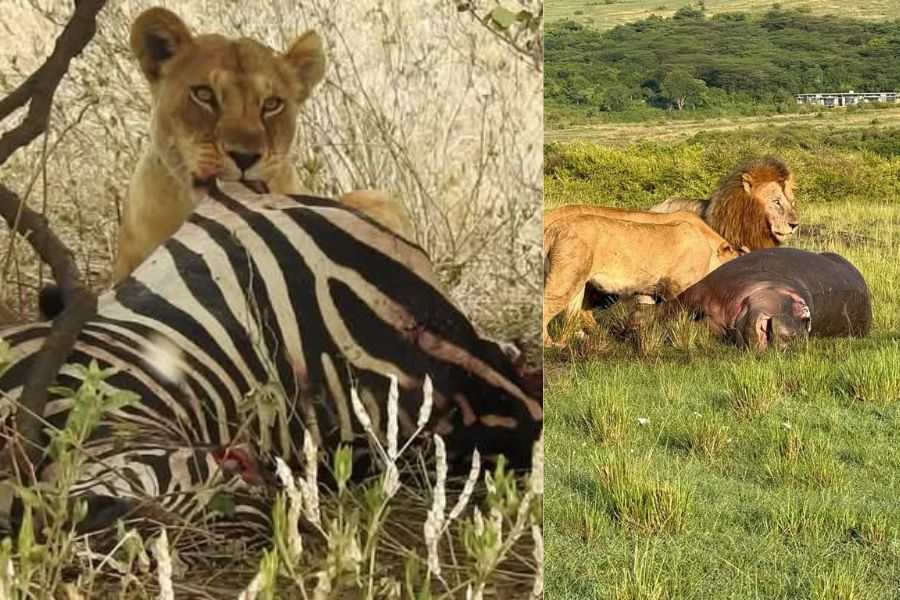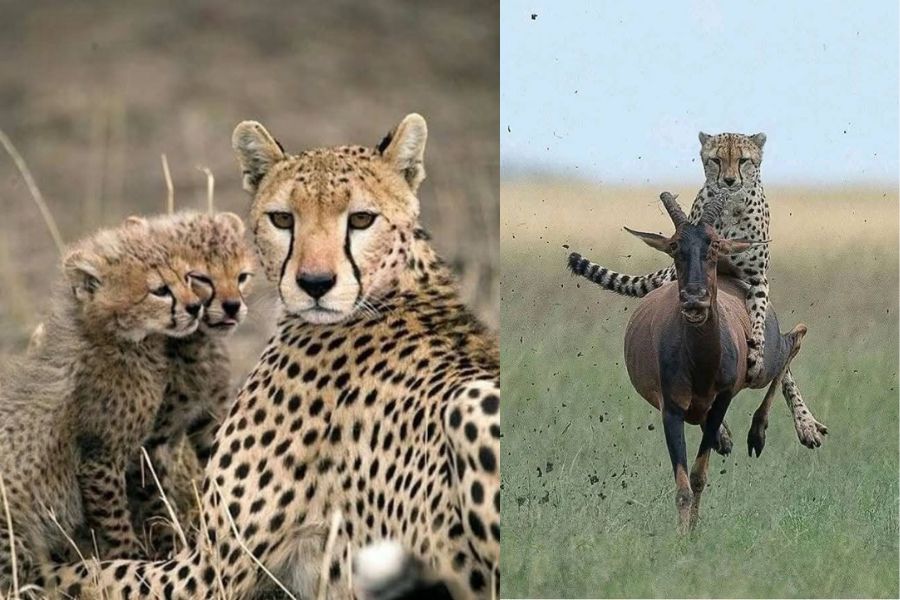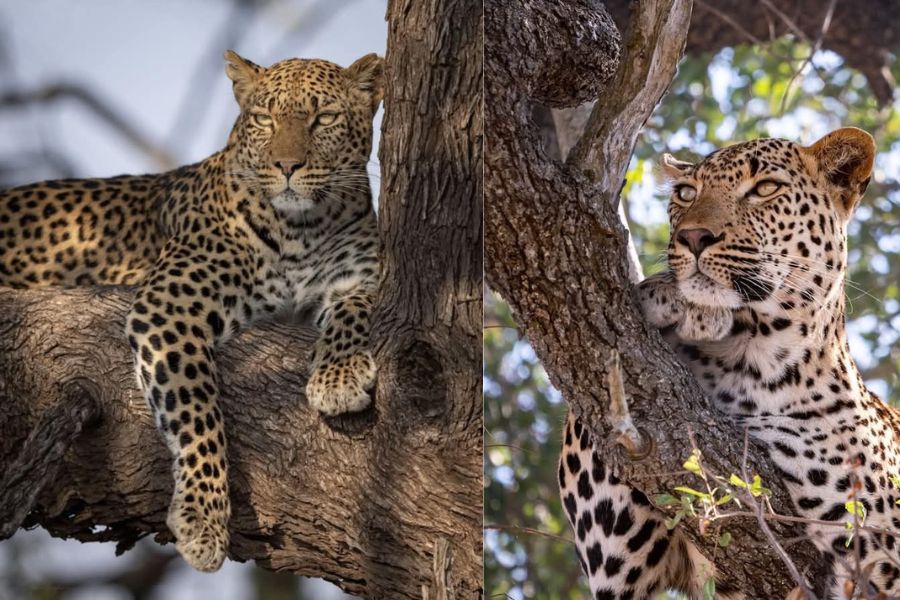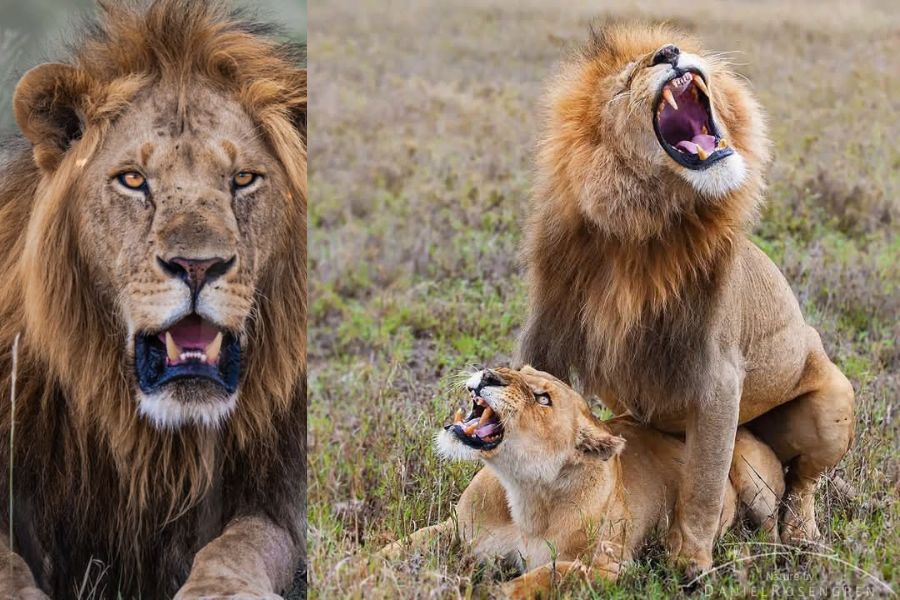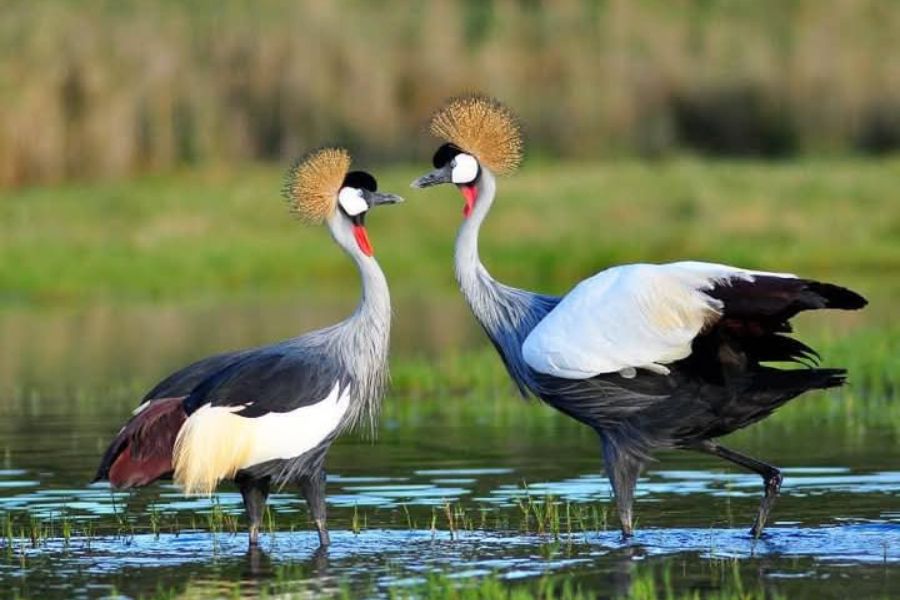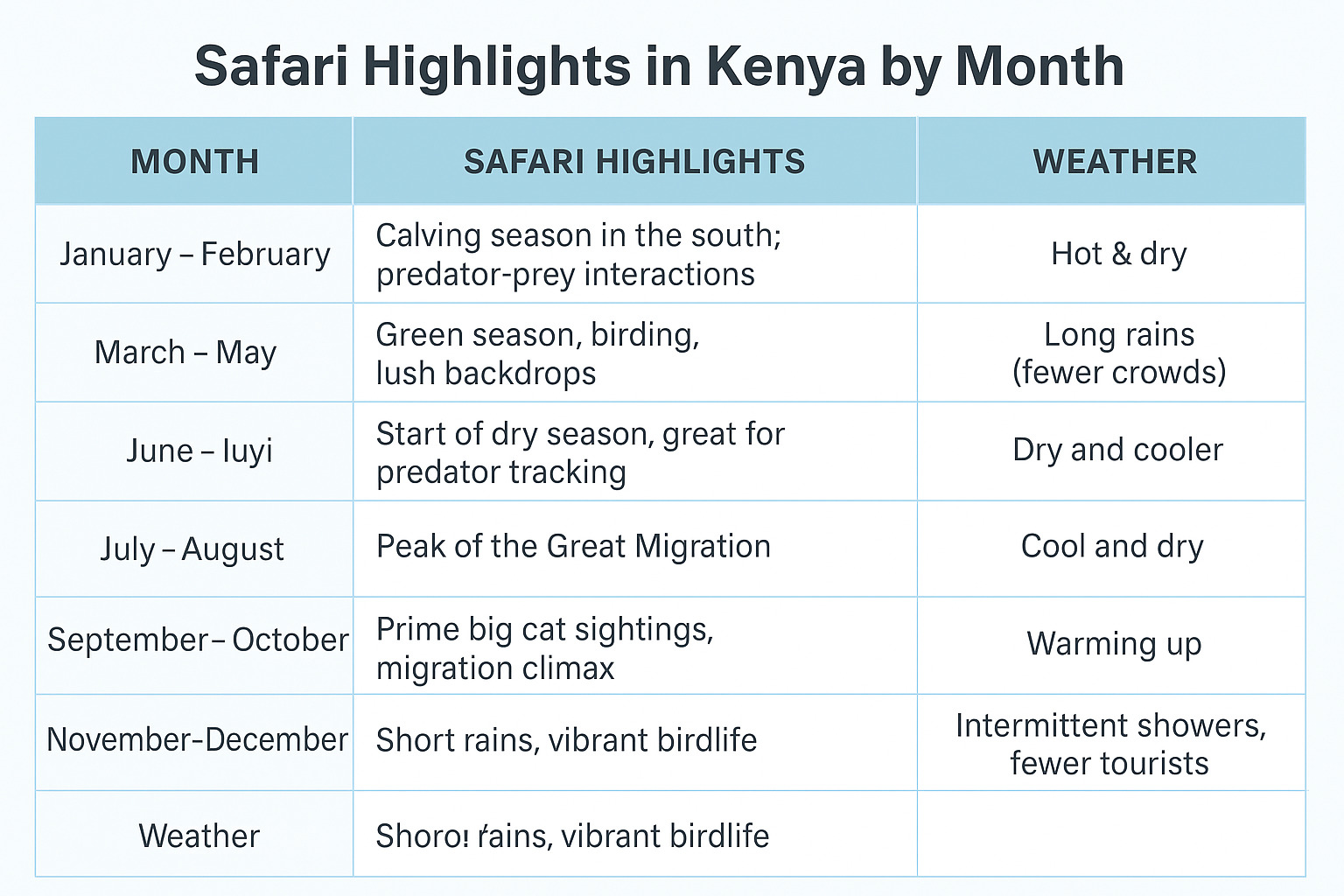
When to Visit Kenya: The Ultimate Guide to Wildlife Safari Seasons
Why Timing Your Safari in Kenya Matters
Kenya is a world-renowned safari destination, offering up-close encounters with the Big Five, thrilling predator action, and the breathtaking spectacle of the Great Wildebeest Migration. But not all months offer the same wildlife experiences. Knowing the best time for a wildlife safari in Kenya can mean the difference between a life-changing adventure and a missed opportunity.
From dry seasons ideal for game drives to green seasons perfect for bird watchers, this guide unpacks the ideal safari window tailored to your travel goals.
Dry Season (June to October): Peak Safari Experience
The dry season is widely recognized as Kenya’s prime safari period — and for good reason. With little to no rainfall, animals are drawn to permanent water sources, making them easier to spot.
Wildlife Highlights:
◾ Big cats like lions and cheetahs roam openly in search of prey.
◾ Elephants gather in large herds near rivers and swamps.
◾ Grasses are short, improving visibility during game drives.
This is also the best time to witness the Great Wildebeest Migration in the Maasai Mara National Reserve, where over 1.5 million wildebeests thunder into Kenya from the Serengeti in Tanzania.
Green Season (November to May): Lush, Affordable & Underrated
The green or wet season, particularly from November to April, is a birdwatcher’s paradise and ideal for those seeking lush landscapes and budget-friendly safari options.
|
Green Season Benefits |
Description |
|---|---|
|
Fewer tourists |
More intimate safari experiences |
|
Lush scenery |
Perfect for photography and vibrant flora
|
|
Baby boom |
Many animals give birth during this time
|
|
Migratory birds |
Species from Europe and Asia flood Kenyan skies
|
If you're traveling as a family and prefer off-peak travel dates with enriching animal interactions, this period aligns beautifully with packages like the 10-Day Kenya Family Safari.
Special Safari Moments: What to Expect Each Month
Kenya’s biodiversity is dazzling year-round, but your travel goals—be it the Great Migration, bird photography, or romantic getaways—will shape when you should go. Here’s a month-by-month breakdown of what you can expect on a wildlife safari:
|
Month
|
Safari Highlights
|
Weather
|
|---|---|---|
|
January – February
|
Calving season in the south; predator-prey interactions
|
Hot & dry
|
|
March – May
|
Green season, birding, lush backdrops
|
Long rains (fewer crowds)
|
|
June
|
Start of dry season, great for predator tracking
|
Dry and cooler
|
|
July – August
|
Peak of the Great Migration
|
Cool and dry
|
|
September – October
|
Prime big cat sightings, migration climax
|
Warming up
|
|
November – December
|
Short rains, vibrant birdlife
|
Intermittent showers, fewer tourists
|
The Great Wildebeest Migration: July to October
This world-famous natural event is the crown jewel of Kenyan safaris. Over 1.5 million wildebeests, accompanied by zebras and gazelles, cross the crocodile-infested Mara River, offering raw drama and incredible photography opportunities.
If the Great Migration is on your bucket list, plan your trip between July and early October. This is also a phenomenal time for big cat sightings, especially cheetahs stalking the open plains.
Romantic Safari? Choose the Shoulder Seasons
If you’re looking for a more private, romantic safari, the shoulder seasons (June and late October) offer excellent weather with fewer tourists. Luxury lodges roll out private game drives, bush dinners, and scenic sundowners, perfect for honeymooners or couples.
For a truly exclusive escape, consider the 12-Day Kenya Luxury Honeymoon Safari, tailored to blend wildlife with intimate experiences like private bush breakfasts and starlit dinners.
Safari Timing Based on Travel Type
Here’s how to pick the best time to go based on your safari style:
|
Traveler Type
|
Best Months Jul – Oct
|
Reasons
High wildlife density, peak visibility
|
|---|---|---|
|
Birdwatchers
|
Nov – Apr
|
Migratory birds arrive
|
|
Photographers
|
Mar – May
|
Vibrant colors, dramatic skies
|
|
Families with Kids
|
De, Feb,
Aug
|
School holidays + accessible safaris
|
|
Couples & Honeymooners
|
Jun, Oct
|
Fewer crowds, excellent weather
|
Top Safari Destinations and Their Peak Seasons
Maasai Mara National Reserve
◾ Best Time: July to October (Great Migration)
◾ Why Go: Iconic big cat sightings, river crossings, dramatic landscapes
Amboseli National Park
◾ Best Time: January to March, June to October
◾ Why Go: Unobstructed views of Mount Kilimanjaro, elephant herds, and birdwatching
Samburu and Laikipia
◾ Best Time: December to March
◾ Why Go: Rare species like Grevy’s zebra and Somali ostrich, cultural experiences with the Samburu tribes
Advantages of Visiting in the Low vs. High Season
Low Season: Fewer Crowds, Greener Landscapes
◾ Discounted rates on lodges and tours
◾ Rich photography opportunities due to vibrant colors
◾ Great for birdwatchers
High Season: Abundant Wildlife and Dry Trails
◾ Ideal for first-timers
◾ High wildlife concentration near waterholes
◾ Best weather conditions for travel and photography
Special Events and Wildlife Experiences by Season
The Wildebeest River Crossings
◾ When: Late July to early October
◾ Where: Mara River, Maasai Mara
◾ What to Expect: A natural drama as herds cross crocodile-infested waters
Birdwatching Highlights
◾ Over 1,100 species recorded in Kenya
◾ Peak birding: November to April during migratory season
Cultural Festivals and Tribal Ceremonies
◾ Lake Turkana Festival (May): Celebrates northern Kenya tribes
◾ Maralal Camel Derby (August): A unique safari-meets-sports event
Travel Tips Based on the Time of Year
Weather & Packing Essentials for Your Safari Month
Kenya’s climate varies by region and season, but general patterns remain consistent. To ensure comfort and preparedness, here’s what you’ll need based on when you visit:
Season Essentials to Pack
◾ Dry (June–October) ➡️Lightweight layers, wide-brim hat, sunscreen, binoculars, dust-resistant camera gear
◾ Wet (March–May, Nov) ➡️Waterproof boots, rain jacket, insect repellent, lens cleaner for camera fog
◾ Year-Round Musts ➡️Neutral-colored clothing, sunglasses, reusable water bottle, quick-dry pants
Packing smart helps you stay agile during game drives and ensures you're always ready for that once-in-a-lifetime wildlife shot.
Booking and Budget Considerations
◾ Book early for July–October safaris (6–12 months in advance)
◾ Travel in shoulder seasons (March or November) for deals
◾ Choose conservancies for private, crowd-free experiences
Avoiding the Crowds: Low-Season Travel Tips
If you’re the kind of traveler who prefers tranquility and exclusivity, Kenya’s low seasons—March through May and November—offer an underrated but rewarding experience.
While these months are wetter and some remote roads can get muddy, lodges often offer substantial discounts, and wildlife is still abundant, albeit slightly more hidden due to the tall grasses. What’s more, this is when newborn animals are out and about, and the dramatic skies make for unforgettable landscape photography.
To make the most of these months:
◾ Choose private conservancies with better road maintenance
◾ Opt for luxury tented camps with all-weather access
◾ Use local guides who can track elusive animals even in dense bush
◾ Opt for luxury tented camps with all-weather access
◾ Use local guides who can track elusive animals even in dense bush
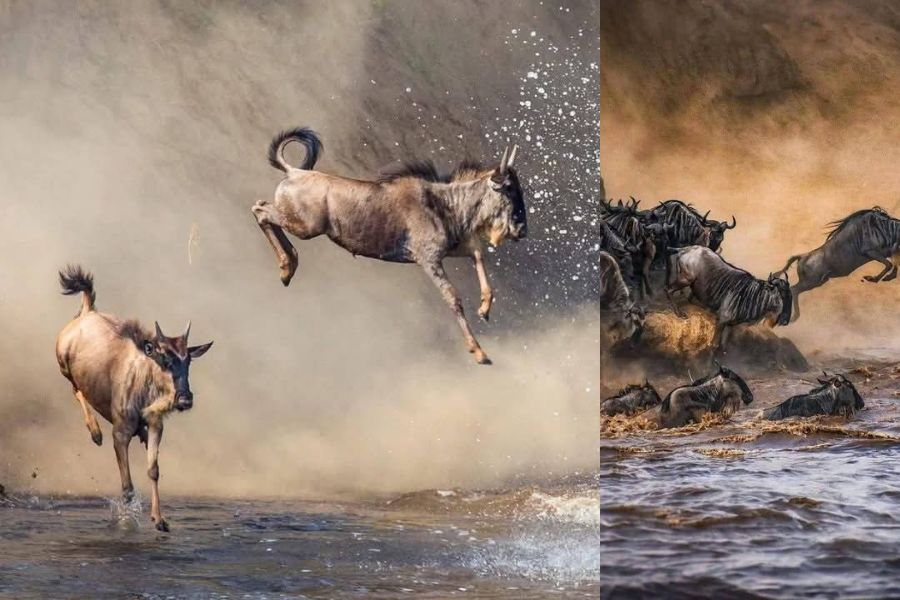
Frequently Asked Questions (FAQs)
1. What is the absolute best month to visit Kenya for a safari?
July to October is considered the best due to the Great Migration and dry weather.
July to October is considered the best due to the Great Migration and dry weather.
2. Is it worth visiting Kenya during the rainy season?
Yes, especially for photographers, birdwatchers, and budget travelers. Just prepare for some muddy roads.
Yes, especially for photographers, birdwatchers, and budget travelers. Just prepare for some muddy roads.
3. What are the cheapest months to go on a Kenyan safari?
April, May, and November typically offer the lowest prices.
April, May, and November typically offer the lowest prices.
4. Are safaris in Kenya safe during all seasons?
Yes, safaris are safe year-round when booked through reputable operators.
Yes, safaris are safe year-round when booked through reputable operators.
5. Can I see the Big Five all year in Kenya?
Absolutely. Parks like Maasai Mara and Amboseli have resident populations viewable all year.
Absolutely. Parks like Maasai Mara and Amboseli have resident populations viewable all year.
6. How far in advance should I book a safari?
For peak season (July–October), book 6–12 months ahead. For the low season, 1–3 months is usually fine.
For peak season (July–October), book 6–12 months ahead. For the low season, 1–3 months is usually fine.
Final Thoughts: Timing Is Everything
Whether you're seeking the raw thrill of the migration, the peaceful charm of the green season, or a romantic getaway under African skies, Kenya has the perfect safari window for you.
Your adventure will be shaped by what you want to see, how you want to experience it, and when you choose to go.
Plan around the wildlife. Time your journey. And let the rhythm of nature lead the way.
